
A pergola is an excellent addition to any outdoor space, providing shade, beauty, and functionality. However, planning a pergola can be a daunting task. There are many design options to choose from, and the construction process can be challenging.
In this article, we’ll share 12 expert tips to help you plan and build the perfect pergola for your backyard or patio. From selecting the right materials to considering your space’s size and layout, these tips will ensure you get the best results possible.
Whether you’re a DIY enthusiast or planning to hire a professional, this guide will provide you with everything you need to know to create a stunning and functional outdoor oasis. So, let’s dive in and get started on your pergola planning journey!
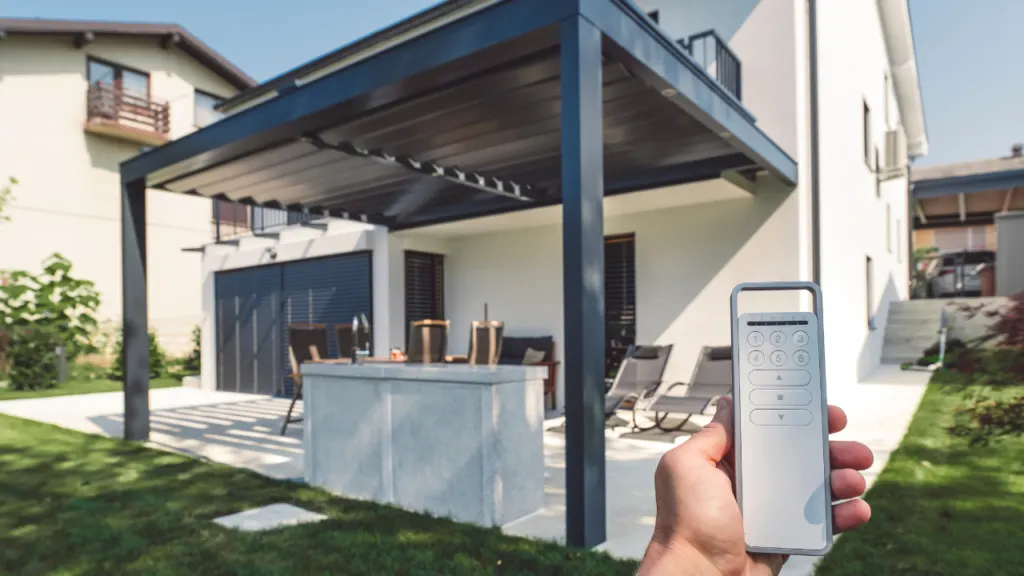
Choosing the Right Location
Assess Your Outdoor Space
To choose the ideal location for the pergola, first assess your available outdoor space. Whether it’s your backyard, garden, or patio, consider the size and layout of the area.
This will help you determine the right spot for the pergola that meets your desired purpose (for example, providing shade, creating a cozy space, or embellishing your pool area).
If you have a large, open area, you may want to place the pergola in the center or at a focal point. Smaller spaces, such as patios or terraces, may benefit from a pergola attached to your home or built against a wall.
Consider Sun, Wind, and Rain
When selecting the location for your pergola, take into account the elements – particularly sun, wind, and rain – as they will have an impact on the comfort, functionality, and durability of the structure.
Sun
It is important to consider the sun’s position throughout the day when planning your pergola. Take time to study the sun’s path in your outdoor space to maximize the shade provided by your pergola.
Based on your findings, carefully decide on the orientation of the pergola, making sure it provides sufficient shade during peak sun hours.
Wind
Wind exposure can also affect the comfort of your outdoor space. To create a sheltered area, consider placing your pergola near trees, fences, or walls which can act as natural wind barriers.
Pay attention to the prevailing wind direction in your location and adjust the orientation of the pergola accordingly.
Rain
Lastly, the pergola should offer some protection against rain. Determine your region’s average rainfall and plan the layout accordingly.
You may choose a design with a slatted or solid roof to provide extra shelter. Consider placing the structure near your home, so you can easily access it during rainy days.
In conclusion, selecting the right location for your pergola is a crucial step in ensuring its long-term usability and satisfaction. Carefully assess your outdoor space, consider the natural elements, and plan accordingly to create an inviting and functional structure that meets your needs.
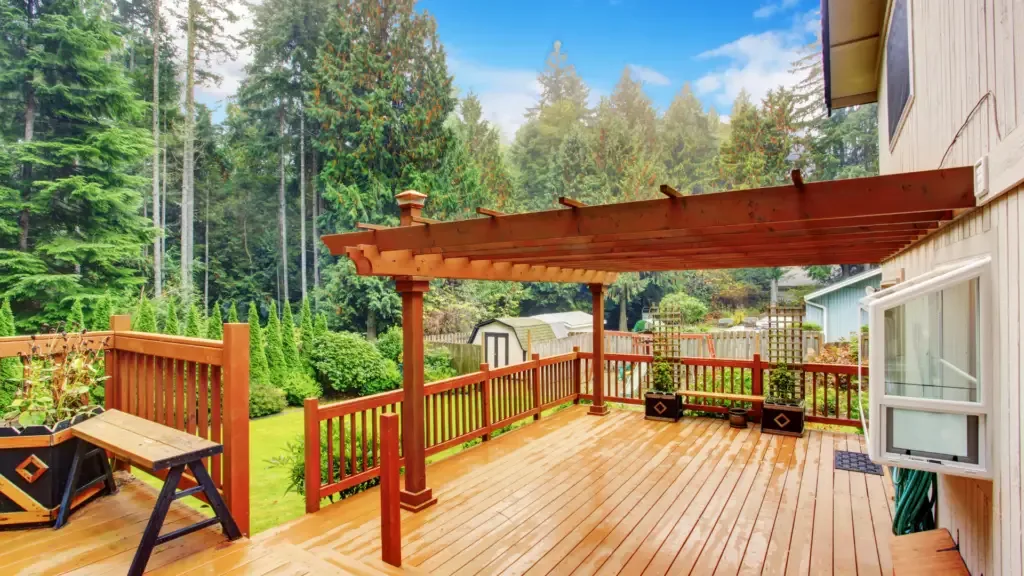
Determining the Size and Design
Dimensions and Proportions
When planning your pergola, it’s crucial to consider the dimensions and proportions that best fit your outdoor space. Consider your furniture and entertainment needs to determine an appropriate size:
- Small group: A 12×16 pergola is suitable for seating up to 6 people.
- Medium group: For accommodating up to 12 people, a 16×20 pergola would be ideal.
- Small patio: For limited spaces, a 12×12 pergola is a suitable choice.
The height of your pergola also comes into play. Use these general guidelines to ensure a comfortable and functional space:
| Area Type | Height Range |
|---|---|
| Small Patio | 8 feet |
| Standard Decks | 10 feet |
Remember to visualize the dimensions in your space and create mock-ups if needed.
Attached vs Freestanding Pergolas
When it comes to design, there are two primary types of pergolas: attached and freestanding. Each has its own benefits and considerations:
- Attached Pergolas: As the name suggests, these pergolas attach to your home, offering a seamless transition from your indoor space to your outdoor area. They save space, making them an excellent choice for smaller patios. However, they might require more attention to structural details and may need to comply with local building codes.
- Freestanding Pergolas: These pergolas stand on their own, offering versatility in placement and design. They’re suitable for larger decks and can be used to create a separate outdoor living area. Keep in mind that they might need additional support and bracing, so plan accordingly.
Remember, the key to a successful pergola plan lies in selecting the appropriate size and design that meets your needs and blends harmoniously with your outdoor space.
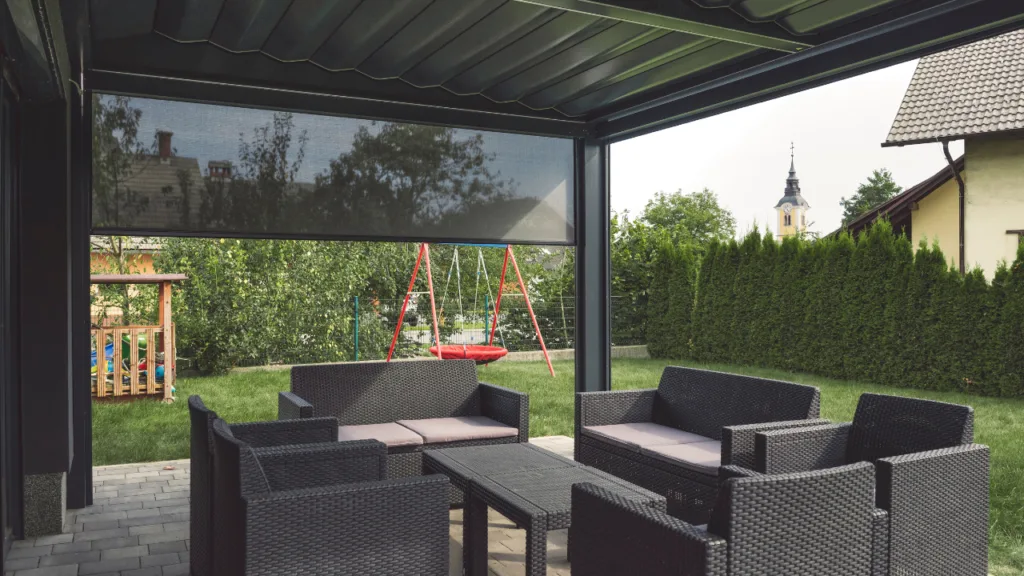
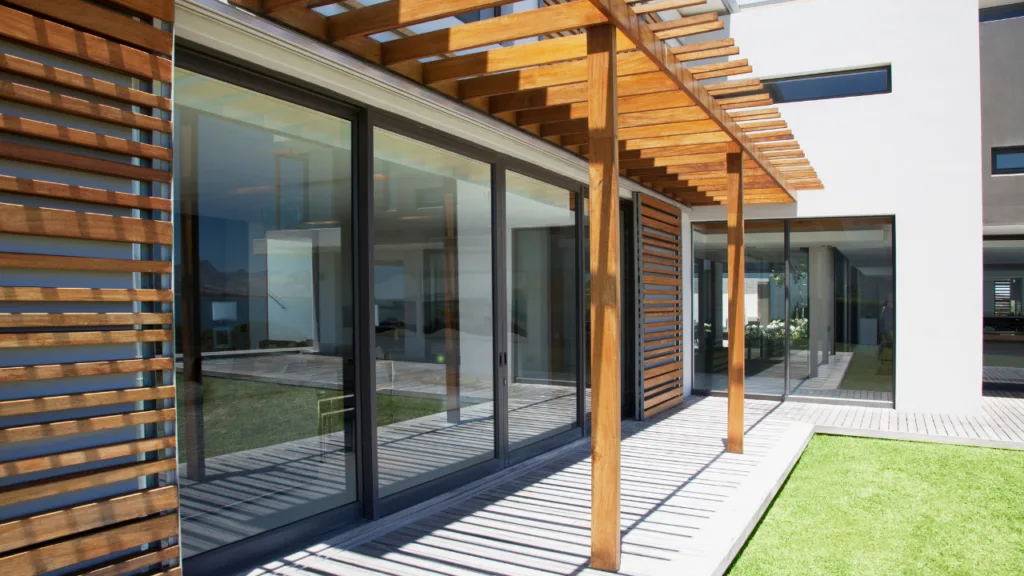
Selecting Materials and Cost
Wood, Metal, and Fiberglass Options
When planning your pergola project, you have various material options, such as wood, metal, and fiberglass. Each of these materials has its unique properties and costs, so it’s essential to choose according to your priorities, aesthetic preferences, and budget.
Wood: Wood is the most traditional material for pergolas, with cedar being a popular choice due to its durability and resistance to insects and the elements.
The cost of lumber may vary depending on your region, but you can expect to spend a few hundred dollars for a 10′ x 10′ pergola, and around $350 to $400 for sizes up to 16′ x 16′.
Metal: Metal pergolas, typically made of aluminum or steel, are known for their durability and modern look. They come in various colors and styles and require minimal maintenance compared to wood. However, they may be more expensive.
Fiberglass: Fiberglass pergolas are lightweight, corrosion-resistant, and low maintenance. They are more expensive than wood but less expensive than metal.
Fiberglass pergolas offer a balance between durability and affordability.
Budgeting for Your Pergola Project
When budgeting for your pergola, keep in mind its size, complexity, and any additional features you want to include, such as lights or fans. The average cost to construct a pergola ranges from $4,000 to $5,900 or about $2,200.
Here’s a breakdown of the different aspects to consider when budgeting:
- Material cost: As mentioned earlier, the cost of materials will depend on your choice between wood, metal, or fiberglass. Be sure to research local prices to accurately budget for your chosen material.
- Labor cost: If you’re not building the pergola yourself, you’ll need to factor in the cost of hiring a contractor. Labor costs vary depending on location and the complexity of the project.
- Additional features: Including extras like lights, fans, or custom designs will increase the overall cost. Keep these add-ons in mind when budgeting to ensure you can accommodate all of your desired features.
Remember to maintain a balance between your preferences and your budget. By carefully selecting the materials and considering all costs, you can create the perfect pergola for your outdoor living space.
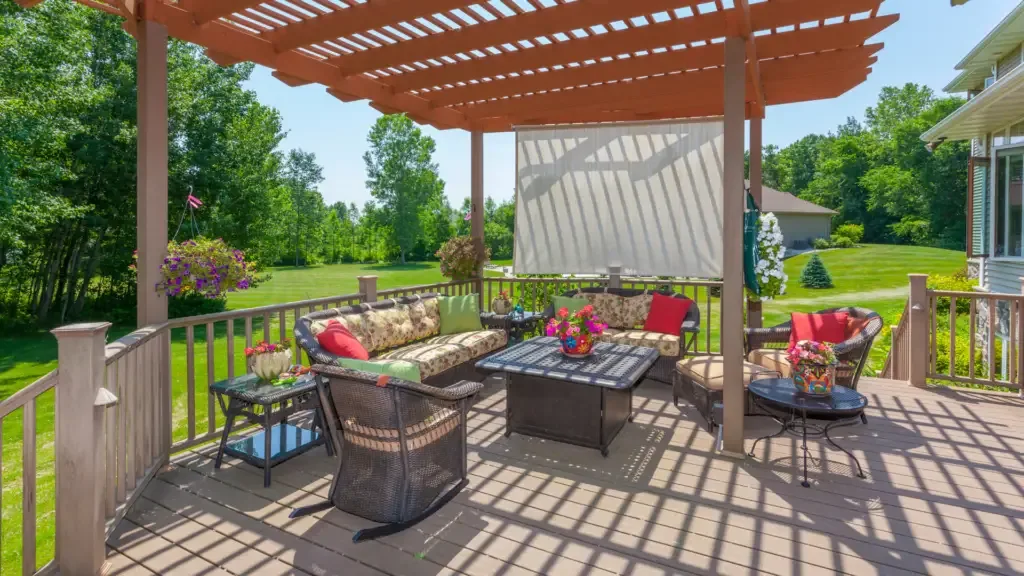
Planning for Construction and Permits
Understanding Building Codes
Before starting your pergola project, familiarize yourself with local building codes and regulations. These may include height restrictions and setback requirements.
By doing so, you ensure that your construction is compliant with local authorities and avoids potential fines or delays. To better understand the building codes in your area:
- Research online or visit your local government office
- Gather information on specific regulations that apply to your project
- Consider consulting with a professional, such as an architect or contractor, for advice
Working with Contractors vs DIY
Deciding whether to hire a contractor or embark on a DIY project is an essential part of pergola planning. Consider the following factors:
Contractors:
- Skills and experience: Contractors have the expertise to ensure quality work and adherence to building codes.
- Time-saving: Hiring a professional may save time as they can complete the project quicker than you could on your own.
- Cost: While contractors may charge a premium for their services, this could be offset by faster completion times and potentially avoiding mistakes.
DIY:
- Cost savings: By handling the project yourself, you can potentially save money on labor costs.
- Personal satisfaction: A DIY project allows you to see your own work come to life and enjoy the process of creating something from scratch.
- Time investment: Keep in mind, a DIY project may take more time to complete, and it’s essential to balance that against other responsibilities and commitments.
When planning your pergola construction, weigh the pros and cons of hiring a contractor versus a DIY approach. Assess your skills, budget, and time constraints to determine which option is the best fit for your home improvement project.
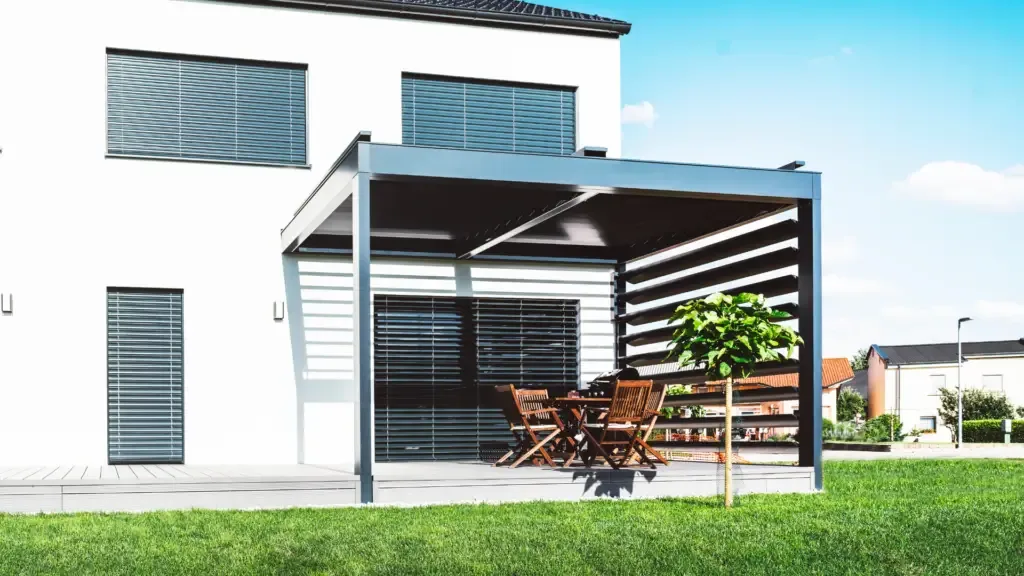
Incorporating Functional Elements
Shade Coverage and Privacy Options
When planning your pergola, consider incorporating functional elements that enhance shade coverage and privacy. One way to increase shade is by optimizing the spacing and size of the rafters.
You can also add a table beneath the pergola to provide a shaded area for dining and relaxation.
Integrating trellis or lattice panels on the pergola’s sides will not only create a sense of privacy but also serve as support for climbing plants, such as roses, which will further increase shade coverage.
Growing climbing roses and other plants on the pergola creates a natural, organic look that can add charm to your outdoor space.
Integrating Lighting and Furniture
In addition to coverage and privacy, it’s essential to think about how you’ll light and furnish your pergola to make the most of it.
Integrating outdoor lanterns or string lights will illuminate your space during evening hours and create a warm, inviting atmosphere. You can hang these lighting options from the rafters, beams, or trellis for a visually appealing effect.
To make your pergola more comfortable and functional, consider adding outdoor furniture that matches your space and style. You could include:
- Patio chairs or benches to create a cozy seating area
- An outdoor table for dining or hosting gatherings
- A hammock or daybed for relaxation
Incorporating these elements will make your pergola a versatile space that you and your guests can enjoy throughout the day and night.
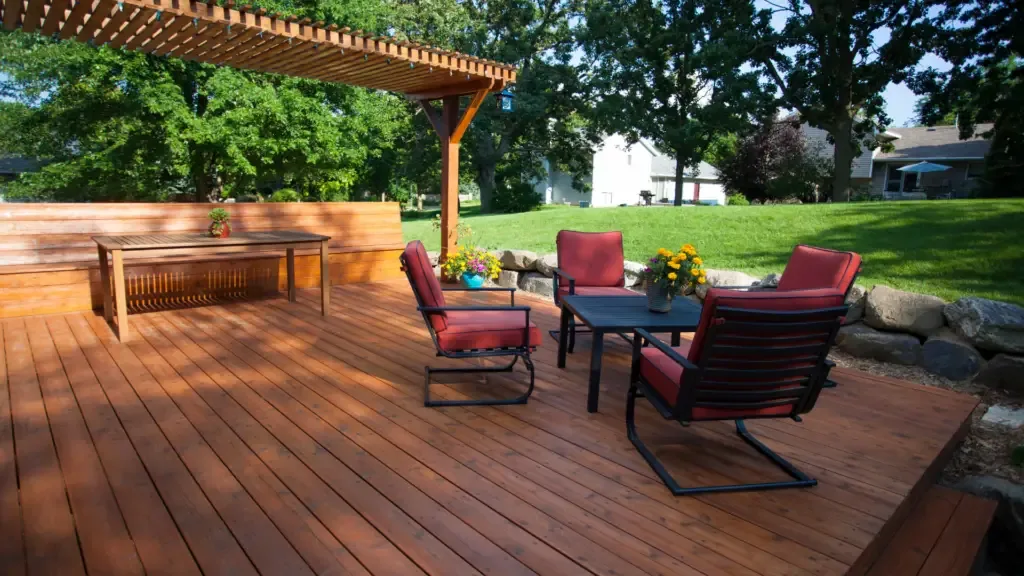
Optimizing Aesthetics and Landscaping
When planning your pergola, it’s important to think about how it will look in your outdoor space. In this section, we’ll explore ways to optimize the aesthetics and landscaping around your pergola, focusing on selecting the best plants and vines and adding outdoor accessories.
Selecting Plants and Vines
Choosing the right plants and vines can make a significant difference in the overall feel and visual appeal of your pergola. Consider the following when selecting your plantings:
- Climate: Choose plants that will thrive in your local climate conditions.
- Maintenance: Some vines and plants require more care than others. Consider your schedule and willingness to invest time in maintaining your pergola’s foliage.
- Color and Texture: Look for plants with complementary colors and interesting textures to create a visually appealing space.
Some popular pergola plant options include roses, wisteria, and climbing hydrangea. Keep in mind that turf can be challenging to maintain under a pergola due to the shade it provides, so choose plants that can handle lower light situations.
Adding Outdoor Accessories
In addition to plants and vines,end.space Customize your pergola with outdoor accessories to further enhance its appearance and functionality:
- Paint: Painting your pergola’s beams can add a touch of color and personal style to the structure. Be sure to select paint specifically designed for outdoor use.
- Outdoor Rug: Consider placing an outdoor rug beneath your pergola to define the space and add comfort underfoot.
- Furniture: Include comfortable seating and tables to make the area more inviting for lounging or entertaining.
- Ceiling Fans and Light Fixtures: Add a ceiling fan for a cool breeze on hot days, and select light fixtures to extend your pergola’s usability into the evening hours. Ensure you allocate enough height in the structure to accommodate these fixtures safely.
Incorporate these elements thoughtfully to create a cohesive, visually appealing space under your pergola. Remember to consider the size, materials, and style of your pergola when selecting plants, vines, and accessories to achieve the optimal aesthetic appeal and functionality.
Enhancing Comfort and Ambiance
Outdoor Seating and Dining Areas
When designing your pergola, consider incorporating comfortable seating arrangements for outdoor dining and entertaining. For a small group of no more than 6 people, a 12×16 pergola is suitable.
However, if you want to seat 12 persons, a larger 16×20 pergola is recommended1. Select weather-resistant furniture and consider adding cushions and pillows for extra comfort.
Create a welcoming ambiance with thoughtful lighting choices. String lights or outdoor LED lights can be installed along the beams or wrapped around the posts of your pergola to create a cozy atmosphere.
Also, using outdoor curtains can provide privacy, shade, and a sense of elegance to your outdoor living space.
Creating a Relaxing Outdoor Retreat
A pergola can become a relaxing retreat in your backyard by adding a few simple elements3. Consider incorporating:
- A porch swing or hammock for lounging
- Soft cushions and pillows for added comfort
- Plants and flowering vines for a natural, lush appearance
- Outdoor soft rugs for underfoot comfort
In addition to the above elements, lighting plays a crucial role in setting the mood for your retreat. Use lanterns, candles, or solar-powered lights for a soothing, warm glow.
Remember, a well-planned pergola can serve as an inviting space for both social gatherings and quiet relaxation. By incorporating comfortable seating, tasteful lighting, and cozy accents, you can create an enchanting outdoor living area that you and your guests will thoroughly enjoy.
Footnotes
- 12 Pergola Planning Tips For Best Results – roofcalc.com ↩
- How to Plan a Pergola – This Old House ↩
- 10 Best Pergola Ideas to Upgrade Your Backyard | Family Handyman ↩
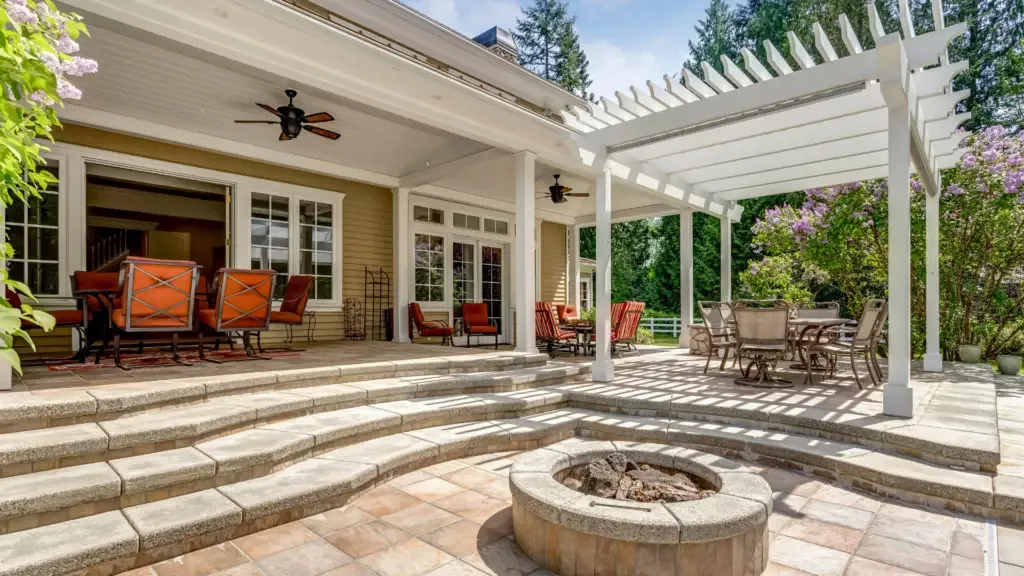
Tips for Pergola Maintenance
Staining and Painting
Pergolas require regular maintenance to keep them looking their best. One way to reduce the amount of maintenance needed is to paint or stain the structure. This will protect the wood from the elements and make it easier to clean.
However, keep in mind that painting or staining a pergola can be both time-consuming and expensive. It’s essential to choose quality paint or stain products to ensure they last, protecting your investment and saving you money in the long run. When staining or painting your pergola, follow these steps:
- Thoroughly clean the pergola. Remove any dirt, mildew, and stains.
- Select a high-quality paint or stain.
- Apply the paint or stain according to the manufacturer’s instructions.
Caring for Plants and Climbing Roses
If you’ve chosen to incorporate plants and climbing roses into your pergola design, it’s essential to care for them properly. Not only do these plants add beauty to your pergola, but they also help cool the area as moisture evaporates from their foliage.
Here are some tips to care for your plants and roses:
- Provide support: Ensure that the pergola has a sturdy framework to support the weight of the plants and roses.
- Prune regularly: Keep your climbing roses tidy and healthy by regularly pruning them. This encourages new growth and helps prevent disease.
- Water wisely: Pay attention to the water needs of your plants and roses. Some plants may require more or less water, depending on their specific needs and the climate.
- Fertilize: Use a balanced fertilizer to encourage healthy growth and flowering. Be sure to follow the fertilizer’s instructions for proper application.
By following these simple maintenance tips, you can keep your pergola looking its best, creating a stunning outdoor space for you and your guests to enjoy.
Popular Pergola Kits and Brands
Cedar Wood Pergola Kits
If you’re looking for a classic and elegant pergola, cedar wood pergola kits are an excellent choice. One of the top brands for cedar wood pergolas is Backyard Discovery.
Their pergola kits come pre-cut, pre-stained, and ready to assemble, making them a popular choice among homeowners.
Cedar wood’s natural resistance to decay and insects makes it an ideal material for outdoor structures like pergolas, gazebos, and arbors.
Additionally, cedar’s natural aesthetic is perfect for blending seamlessly with your backyard’s environment, creating a harmonious space where you can enjoy your outdoor living area.
Modern Pergola Designs
For those seeking contemporary style and functionality, modern pergola designs offer a sleek and versatile option. Some of the top pergola kits in this category are:
- Aluminum Pergolas: These pergolas boast a durable and lightweight structure with a sleek design. One top brand to consider is the Coolaroo Aurora Pergola, offering UV protection and a retractable shade on a sturdy aluminum frame.
- Retractable Pergolas: For added functionality, the PURPLE LEAF 10′ x 12′ Outdoor Retractable Pergola provides the option of opening and closing the canopy as needed, allowing you to control the level of shade in your space.
- Louvered Pergolas: A notable option is the Purple Leaf Outdoor Louvered Pergola, which features adjustable hardtop louvers that can be angled to create the perfect shelter from the sun.
- Vinyl Pergolas: For a low-maintenance and weather-resistant option, consider the Wallsend 12′ W x 12′ D Vinyl Pergola.
When choosing a modern pergola design, consider factors such as your backyard’s overall aesthetic, the pergola’s intended purpose, and what features are most important to you. Ultimately, the right pergola kit will enhance your outdoor living area, providing an inviting space where you and your loved ones can enjoy.
Use the information above to help you select the perfect pergola kit for your needs. Whether you prefer the natural appeal of cedar wood or the sleek functionality of a modern pergola design, there are countless options available to turn your backyard into an outdoor oasis

